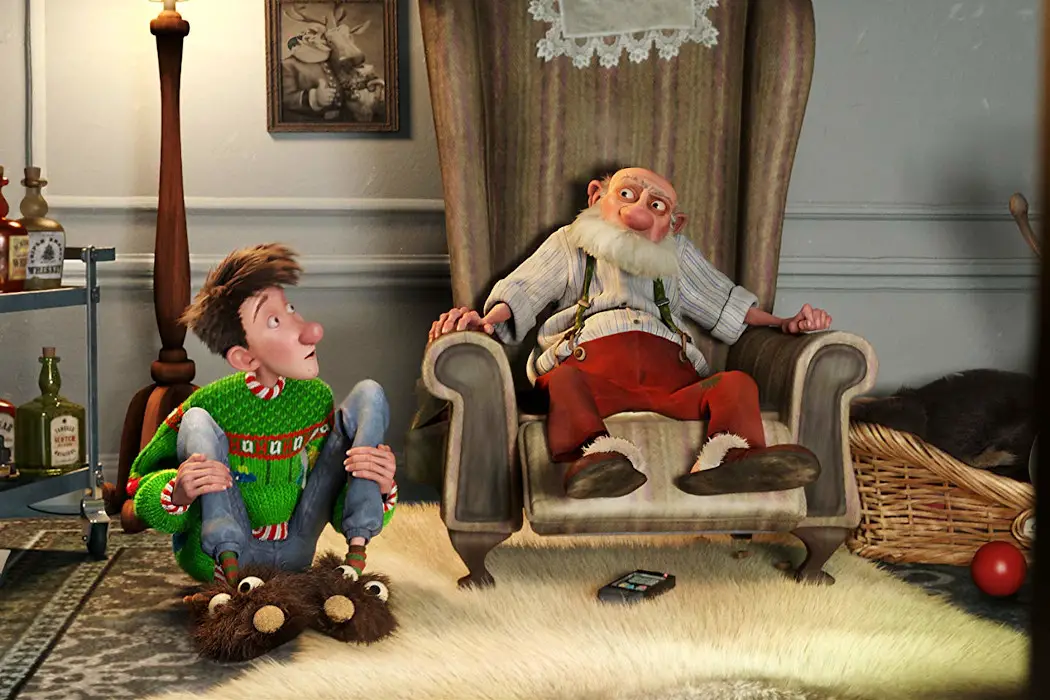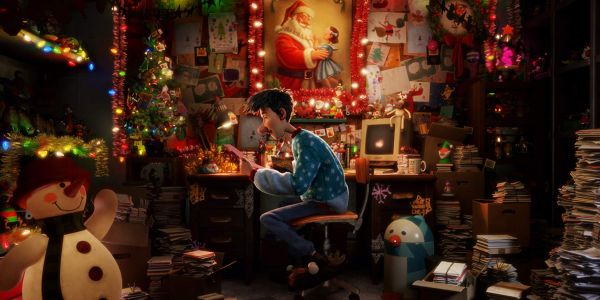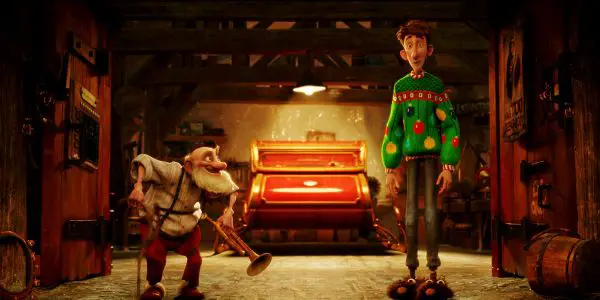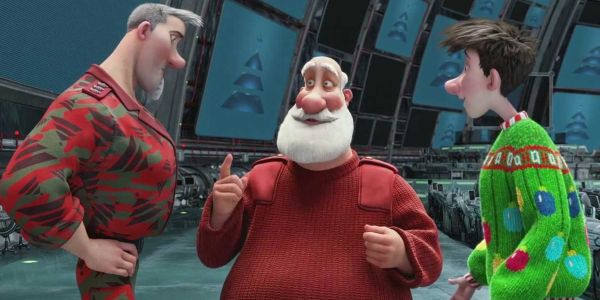“OK, Boomer:” How ARTHUR CHRISTMAS Predicted Our Inter-generational Conflict

Danny Anderson teaches English at Mount Aloysius College in PA.…
2011’s underrated animated Christmas film Arthur Christmas (co-directed by Sarah Smith and Barry Cook) is a fun holiday comedy that tells the absurd story of how Santa’s clumsy, naive youngest son takes over the family business. But there is so much more to this film.
The delightful ensemble cast features the voices of James McAvoy, Hugh Laurie, Bill Nighy, and Jim Broadbent as four generations of the Santa dynasty, each of whom have a competing vision for the role. Grand Santa (Nighy) longs for the rough and tumble “good old days” when he was Santa and approached the job as a high-spirited adventurer. His son, the current Santa (Broadbent), now largely performs a ceremonial role as his eldest son Steve (Laurie), runs the “operation” as a tech-savvy CEO might. Steve is the heir-apparent, and tradition holds that after 70 “missions” Santa should retire, but the current Santa surprises everyone and refuses to relinquish his place in the spotlight.
Lost in the shuffle is Santa’s youngest son, Arthur (McAvoy), a childlike, naïve, goof who still sees Santa and Christmas as nothing short of magical, just like the rest of the children Santa serves.
During the course of the comedy, a child’s bicycle fails to get delivered and the four competing Santa’s approach the problem in vastly different ways. Arthur is aghast at the possibility of Santa Claus forgetting a single child out of billions. Current Santa is ready for bed and defers to Steve who insists that the mission was overwhelmingly successful and argues that little Gwen will get her bike “in the window of Christmas” – technocratic lingo at its finest. Grand Santa, feeling left behind by the passage of time, convinces Arthur to break out with the old sleigh and eight tiny reindeer to deliver the lost bike. Grand Santa’s motives turn out to be nothing more than a selfish grasp at relevance, however, and only Arthur, ridiculous Arthur, understands what is really at stake.
“Ok, Boomer”
Watching this film again in 2019, one cannot help but think of the recent internet phenomenon surrounding the phrase “Ok, Boomer.”

As the world burns around us, each generation seemingly blames the others for our collective problems, and Baby Boomers have earned a reputation for unfairly maligning the values and work ethic of Millennials and Gen Z. Instead of bootstrapping their way to suburban bliss as the Boomers supposedly did, These Kids Today are snowflakes who just want “free stuff” so that’s why they like Bernie.
The Millennials of course have taken the brunt of this straw man argument for the past several years, but now that they are pushing 40, Boomers and the allies they have among Generation X (my own age cohort) have shifted their assault to Gen Y…Gen Z…whatever we’re calling the youngs now.
Collectively exhausted by the effort of refuting inane talking points, the internet invented a dismissive retort that said it all: “OK Boomer.” And this became the phase that launched a thousand tweets, effectively cutting off bad-faith arguments while appropriately humiliating the offenders.
Was “OK, Boomer” a necessary development? Absolutely. Did it become an overused tool of bad-faith arguers itself? Absolutely.
Arthur Christmas shows a better way.
Four Generations In Conflict
Each Santa in Arthur Christmas represents a distinct generation, and their ideological conflict offers a pretty effective representation of the struggles of our own time.
Grand Santa has somehow made it into his 13th decade of life. His glory days took place in a world unrecognizable to us now. His time as Santa took him through the great wars of the century and his 70 missions were punctuated by gunfire and danger. His worldwide gift-giving was an epic adventure and success hinged on his own steely nerves, a lust for action, and a sprinkle of magic dust.
By the time current Santa took over, the world was at peace, and like the rest of his postwar generation, Santa has been able to simply enjoy the accolades that come with his position. The struggles of his father’s generation became monotonous, exaggerated war stories and this Santa’s main problem is one of identity: who would he be if not for his position? And with Steve running everything, Santa can keep being Santa for the foreseeable future.

But the days of the current Santa’s peace cannot last forever, and Steve, the classic Gen Xer understands that a transforming global economy will leave the old family business behind if it does not modernize. So Steve has developed a massive technological approach to the Claus’s business. The old sleigh has been replaced by the S-1, a hyper-advanced craft that can deliver the goods with an unimaginable efficiency. This technology of course requires a vast corporate bureaucracy with him as a Steve Jobs-type CEO. He has kept the business relevant and looks forward to his day in the suit.
Finally there is Arthur, who has no expectation of an inheritance. As the younger and, well, less competent child, he understands his role will always be one of service. But Arthur is special in that his particular service, answering childrens’ letters to Santa is perfectly suited to the spirit behind the business the other men compete to control. Arthur doesn’t want to run anything, he wants to make children happy and his service to the idea of Santa Claus is his way of doing it. At the end of the film, everyone understands that the best way he can serve this idea is by being Santa himself, but it is the meaning behind the position that motivates Arthur.
So between the four Santas we see four irreconcilable value systems: self-centered nostalgia for the moral simplicity of the “good old days;” consumeristic, self-satisfied complacency with the status quo; a hyper-ambitious, technocratic dedication to business and personal advancement; and a generation with no real hopes for the future, only a naïve, wonder-filled desire for meaning now.
Generational Reconciliation
2019 was a Hell of a year. And there is a certain justice to the dismissiveness of the “OK, Boomer” response. But to leave it at that serves only to cut one generation off from the wisdom of the others. And by this, I don’t only mean that the young must learn from the old. The old have much to learn from the young as well.
This inter-generational reconciliation is what makes Arthur Christmas such a lovely film. By the end of the movie, everyone not only realizes that Arthur is best suited to take up the role of Santa, they each come to a better understanding of themselves and how they can best serve the mission of Santa Claus.

Grand Santa, of the “Greatest Generation” comes to see the follow of his nostalgic exaggerations and the limitations of his world’s wisdom. What he has learned from Arthur helps Arthur learn his own lessons.
The Boomer Santa sees how his selfishness has stunted the potential of his children and he finally steps aside to let the younger generations take the reins. Arthur’s courage inspires a maturing change in Santa and through that change, Arthur is allowed to become who he was meant to be.
Steve, when confronted with Arthur’s selfless love for children sees his own profound self-absorption and he steps aside to do what he does best, run the business end of the operation. He finds happiness himself doing what he is best at, and becomes an essential part of Arthur’s future success as Santa.
But the youngest member of the group is not without room for growth in this story. Through his adventure, and with the help of his elders, he understands that he must step up, leave the comfort of the mail room, and take a leadership role. And he notably does not toss out all he inherits, but he makes full use of Steve’s S-1 to do his work as a more authentic, meaningful Santa.
Each generation’s Santa reconciles with the others to create a community of support that can once again serve the children of the world rather than their individual desires.
The film begins with an “Ok, Boomer” critique of older generations, but moves beautifully beyond it. Arthur Christmas offers a world where old and new work together, tossing out destructive baggage while keeping both wisdom and progress. All to “Make Someone Happy.”
Does content like this matter to you?
Become a Member and support film journalism. Unlock access to all of Film Inquiry`s great articles. Join a community of like-minded readers who are passionate about cinema - get access to our private members Network, give back to independent filmmakers, and more.
Danny Anderson teaches English at Mount Aloysius College in PA. He tries to help his students experience the world through art. In his own attempts to do this, he likes to write about movies and culture, and he produces and hosts the Sectarian Review Podcast so he can talk to more folks about such things. You can find him on Twitter at. @DannyPAnderson.













